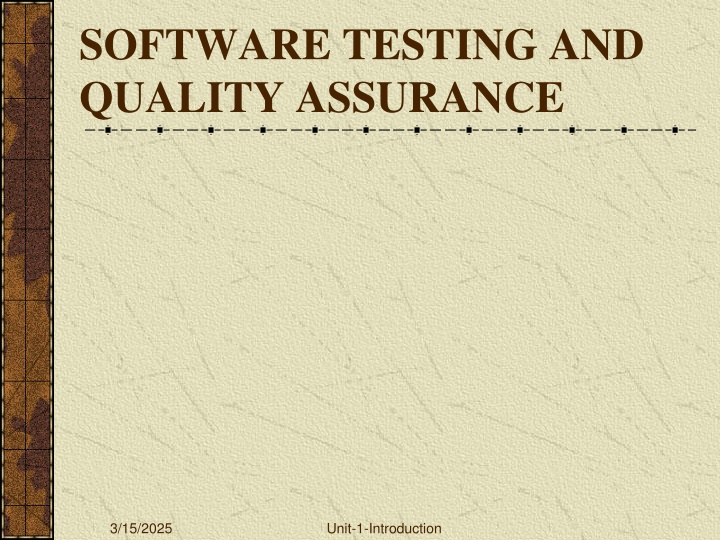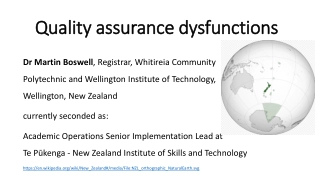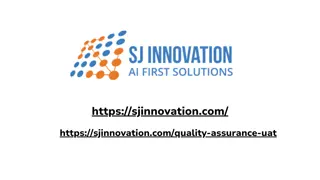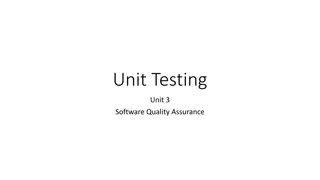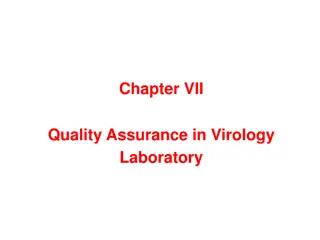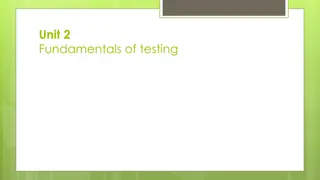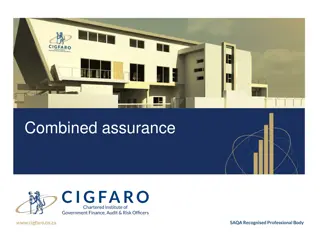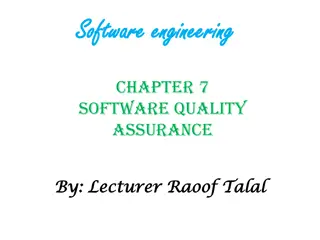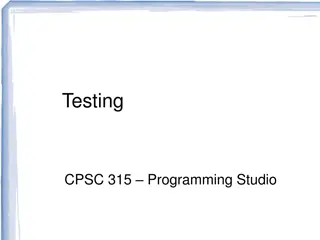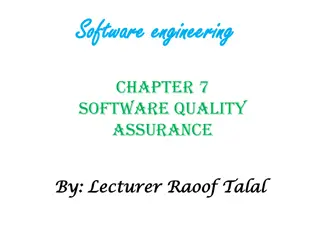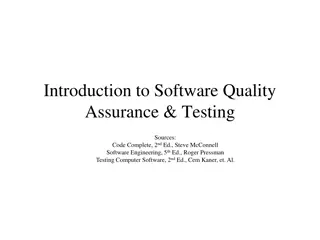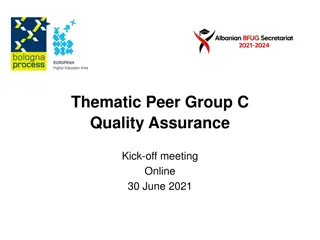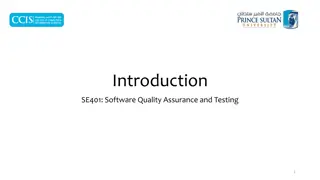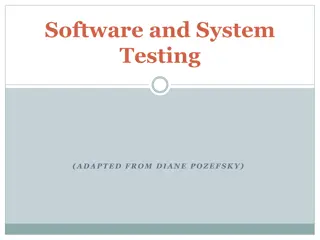Introduction to Software Testing and Quality Assurance
Fundamental concepts in software testing, quality assurance, and automation testing. Learn about software quality, test plan design, automation tools, and quality management principles. Understand the importance of quality assurance in software development.
Download Presentation

Please find below an Image/Link to download the presentation.
The content on the website is provided AS IS for your information and personal use only. It may not be sold, licensed, or shared on other websites without obtaining consent from the author.If you encounter any issues during the download, it is possible that the publisher has removed the file from their server.
You are allowed to download the files provided on this website for personal or commercial use, subject to the condition that they are used lawfully. All files are the property of their respective owners.
The content on the website is provided AS IS for your information and personal use only. It may not be sold, licensed, or shared on other websites without obtaining consent from the author.
E N D
Presentation Transcript
SOFTWARE TESTING AND QUALITY ASSURANCE 3/15/2025 Unit-1-Introduction
CORE OBJECTIVE Introduce basic concepts of software testing Understand white box, block box, object oriented, web based and cloud testing Know in details automation testing and tools used for automation testing Understand the importance of software quality and assurance software systems development. 3/15/2025 Unit-1-Introduction
CORE OUTCOMES Define and describe fundamental concepts in software testing such as manual testing, automation testing and software quality assurance. Design and develop project test plan, design test cases, test data, and conduct test operations. Describe fundamental concepts of automation testing . Apply selenium automation tool for various software testing for testing software. Understand different approaches of quality management, assurance, and apply quality standard to software system. Apply and analyze effectiveness Software Quality Tools 3/15/2025 Unit-1-Introduction
INTRODUCTION Introduction Historical Perspective Definition Core Components Quality View Financial Aspect Customer Suppliers and Process Total Quality Management(TQM) Quality Management Through Statistical Process Control Cultural Changes Continual Improvement Cycle Quality In Different Areas Benchmarking and Metrics Problem Solving Techniques Problem Solving Software Tools 3/15/2025 Unit-1-Introduction
INTRODUCTION(Conti..) Software Quality. Constraints of Software Product. Customer is a King. Quality and Productivity Relationship. Requirements of Products. Organization Culture. Software Development Process. Types of Product. Problematic areas of SDLC. Software Quality Management. Why Software has a defects? Processes related to Software Quality. Pillars of Quality Management System. Important aspects of quality Management. 3/15/2025 Unit-1-Introduction
INTRODUCTION Software Quality Quality: The degree to which a component, system or process meets specified requirements and/or user/customer needs and expectations. Software Quality: The totality of functionality and features of a software product that bear on its ability to satisfy stated or implied needs. OR SOFTWARE QUALITY is the degree of conformance to explicit or implicit requirements and expectations. Explicit: clearly defined and documented Implicit: not clearly defined and documented but indirectly suggested Requirements: business/product/software requirements Expectations: mainly end-user expectations 3/15/2025 Unit-1-Introduction
INTRODUCTION(conti) Software testing is a process of executing a program or application with the intent of finding the software bugs. It can also be stated as the process of validating and verifying that a software program or application or product: Meets the business and technical requirements that guided it s design and development Works as expected Can be implemented with the same characteristic. 3/15/2025 Unit-1-Introduction
INTRODUCTION(conti) The software system needs to be checked for its intended behavior and direction of progress at each development stage to avoid duplication of efforts, time and cost overruns, and to assure completion of the system within stipulated time. The software system needs to be checked for its intended behavior and direction of progress at each development stage to avoid duplication of efforts, time and cost overruns, and to assure completion of the system within stipulated time. System testing and quality assurance come to aid for checking the system. It includes Product level quality (Testing) Process level quality. 3/15/2025 Unit-1-Introduction
TESTING Testing is the process or activity that checks the functionality and correctness of software according to specified user requirements in order to improve the quality and reliability of system. It is an expensive, time consuming, and critical approach in system development which requires proper planning of overall testing process. Characteristics of System Testing System testing begins at the module level and proceeds towards the integration of the entire software system. Different testing techniques are used at different times while testing the system. It is conducted by the developer for small projects and by independent testing groups for large projects. 3/15/2025 Unit-1-Introduction
WHY IS SOFTWARE TESTING NECESSARY? Software Testing is necessary because we all make mistakes. Some of those mistakes are unimportant, but some of them are expensive or dangerous. We need to check everything and anything we produce because things can always go wrong humans make mistakes all the time. Software testing is very important because of the following reasons: Software testing is really required to point out the defects and errors that were made during the development phases. It s essential since it makes sure of the Customer s reliability and their satisfaction in the application. It is very important to ensure the Quality of the product. Quality product delivered to the customers helps in gaining their confidence. (Know more about Software Quality) 3/15/2025 Unit-1-Introduction
Conti.. Testing is necessary in order to provide the facilities to the customers like the delivery of high quality product or software application which requires lower maintenance cost and hence results into more accurate, consistent and reliable results. Testing is required for an effective performance of software application or product. It s important to ensure that the application should not result into any failures because it can be very expensive in the future or in the later stages of the development. It s required to stay in the business. 3/15/2025 Unit-1-Introduction
WHAT ARE SOFTWARE TESTING OBJECTIVES AND PURPOSE? Software Testing has different goals and objectives.The major objectives of Software testing are as follows: Finding defects which may get created by the programmer while developing the software. Gaining confidence in and providing information about the level of quality. To prevent defects. To make sure that the end result meets the business and user requirements. To ensure that it satisfies the BRS that is Business Requirement Specification and SRS that is System Requirement Specifications. To gain the confidence of the customers by providing them a quality product. 3/15/2025 Unit-1-Introduction
STAGES OF SYSTEM TESTING Test Strategy It is a statement that provides information about the various levels, methods, tools, and techniques used for testing the system. It should satisfy all the needs of an organization. 3/15/2025 Unit-1-Introduction
TEST PLAN It provides a plan for testing the system and verifies that the system under testing fulfils all the design and functional specifications. The test plan provides the following information Objectives of each test phase Approaches and tools used for testing Responsibilities and time required for each testing activity Availability of tools, facilities, and test libraries Procedures and standards required for planning and conducting the tests Factors responsible for successful completion of testing process 3/15/2025 Unit-1-Introduction
TEST CASE DESIGN Test cases are used to uncover as many errors as possible in the system. A number of test cases are identified for each module of the system to be tested. Each test case will specify how the implementation of a particular requirement or design decision is to be tested and the criteria for the success of the test. The test cases along with the test plan are documented as a part of a system specification document or in a separate document called test specification or test description. 3/15/2025 Unit-1-Introduction
TEST PROCEDURES It consists of the steps that should be followed to execute each of the test cases. These procedures are specified in a separate document called test procedure specification. This document also specifies any special requirements and formats for reporting the result of testing. Test Result Documentation Test result file contains brief information about the total number of test cases executed, the number of errors, and nature of errors. These results are then assessed against criteria in the test specification to determine the overall outcome of the test. 3/15/2025 Unit-1-Introduction
HISTORICAL PERSPECTIVE 3/15/2025 Unit-1-Introduction
DEFINATIONS OF QUALITY Customer-Based Definition of Quality. Quality must have fitness foe use and meet customer needs ,requirements and help in achieving customer satisfaction and customer delight. Manufacturing-Based Definition of Quality. This approach gives conformance to requirements. Product-Based Definition of Quality. Product must have something that other similar products do not have which help customer satisfy their needs in better way. Value-Based Definition of Quality. Customer must get value for his investment by buying product. Transcendent Quality. A product must have zero defects so that it does not prohibit normal usage by the users. 3/15/2025 Unit-1-Introduction
CORE COMPONENTS OF QUALITY Quality is based on Customer satisfaction by acquiring a product. The organization must define quality parameters before it can be achieved. The cycle of measurement include, Define , Measure, Monitor, Control, Measure. Management Must Lead Organisation through improvement efforts. Continuous Process improvement is necessary. 3/15/2025 Unit-1-Introduction
QUALITY VIEW(cont.) Different views of Quality. Transcendental view User view Manufacturing view Product view Value-based view 3/15/2025 Unit-1-Introduction
QUALITY VIEW(cont.) Transcendental view Quality is something that can be recognized through experience, but not defined in some tractable form. A good quality object stands out, and it is easily recognized. User view Quality concerns the extent to which a product meets user needs and expectations. Is a product fit for use? This view is highly personalized. A product is of good quality if it satisfies a large number of users. It is useful to identify the product attributes which the users consider to be important. This view may encompass many subject elements, such as usability, reliability, and efficiency 3/15/2025 Unit-1-Introduction
QUALITY VIEW(cont.) Manufacturing view This view has its genesis in the manufacturing industry auto and electronics. Key idea: Does a product satisfy the requirements? Any deviation from the requirements is seen as reducing the quality of the product. The concept of process plays a key role. Products are manufactured right the first time so that the cost is reduced Development cost Maintenance cost Conformance to requirements leads to uniformity in products. Some argue that such uniformity does not guarantee quality. Product quality can be incrementally improved by improving the process. 3/15/2025 Unit-1-Introduction
QUALITY VIEW(cont.) Product view Hypothesis: If a product is manufactured with good internal properties, then it will have good external properties. One can explore the causal relationship between internal properties and external qualities. Example: Modularity enables testability. Value-based view This represents the merger of two concepts: excellence and worth. Quality is a measure of excellence, and value is a measure of worth. Central idea How much a customer is willing to pay for a certain level of quality. Quality is meaningless if a product does not make economic sense. The value-based view makes a trade-off between cost and quality. 3/15/2025 Unit-1-Introduction
FINANCIAL ASPECT OF QUALITY -Quality affects all aspects of the organization -Quality has dramatic cost implications of: Quality control costs Prevention costs Appraisal costs Quality failure costs Internal failure costs External failure costs Sales Price is defined as, Sales Price=Cost of Manufacturing+ Cost of Quality + Profit 3/15/2025 Unit-1-Introduction
CUSTOMER ,SUPPLIERS AND PROCESSES For any Organisation ,there are some suppliers supplying the inputs required and some customers who will be buying the output produced. Supplier and customers may be internal or external to the organization. External supplier provide input to the organization and external customers receive the output of the organization. Suppliers may be customer for some organization and external customers receives the output of the organization. Internal Customer: Internal customer are the functions and projects serviced and supported by some other functions / projects. System administration may have projects as their customer while purchasing may have system administration as their customer. External Customer: External customer are the external people to the organization who will be paying for the services offered by the organization. 3/15/2025 Unit-1-Introduction
TOTAL QUALITY MANAGEMENT(TQM) Total Quality Management (TQM) efforts to position a company for greater customer satisfaction, profitability and competitiveness. TQM principle intends to view internal and external customers as well as internal and external suppliers for each process and project and entire organization as whole Meeting Our Customer s Requirements Doing Things Right the First Time; Freedom from Failure (Defects) Consistency (Reduction in Variation) Continuous Improvement Quality in Everything We Do 3/15/2025 Unit-1-Introduction
TOTAL QUALITY MANAGEMENT(TQM) (Conti..) Focus on Customer Identify and meet customer needs Stay tuned to changing needs, e.g. fashion styles Continuous Improvement Continuous learning and problem solving, e.g. Kaizen, 6 sigma Plan-D-Study-Act (PDSA) Benchmarking Employee Empowerment Empower all employees; external and internal customers Team Approach Teams formed around processes 8 to 10 people Meet weekly to analyze and solve problems Use of Quality Tools Ongoing training on analysis, assessment, and correction, & implementation tools Studying practices at best in class companies 3/15/2025 Unit-1-Introduction
QUALITY MANAGEMENT THROUGH STASTICAL PROCESS CONTROL Statistical process control is a collection of tools that when used together can result in process stability and variance reduction Statistical Process Control (SPC) is an industry-standard methodology for measuring and controlling quality during the manufacturing process. Quality data in the form of Product or Process measurements are obtained in real-time during manufacturing. This data is then plotted on a graph with pre- determined control limits. Control limits are determined by the capability of the process, whereas specification limits are determined by the client's needs. Quality Planning at all level Quality Planning at Organization level. Quality Planning at Unit level. Statistical Process Control monitoring production process to detect and prevent poor quality Sample subset of items produced to use for inspection 3/15/2025 Unit-1-Introduction
QUALITY MANAGEMENT THROUGH CULTURAL CHANGES Quality Management through cultural change defines quality improvements as a cultural change driven by management. It involves -Identifying areas in which quality can be improved depending upon process capability measurements and organizational priorities. -Identifying teams representing different functions and areas for quality improvement can help in setting the change of culture. -Setting measurable goals in each areas of an organization can help in improving processes at all levels. -Giving recognition to achievers of quality goals will boost their morale and set positive competition among team leading to organizational improvements. Creating a quality culture within an organization is increasingly recognized as one of the primary conditions for the successful implementation of Total Quality Management 3/15/2025 Unit-1-Introduction
CONTINUAL IMPROVEMENT CYCLE(Conti) Continuous improvement is an ongoing effort to improve products, services or processes. These efforts can seek incremental improvement over time or breakthrough improvement all at once. Among the most widely used tools for continuous improvement is a four-step quality model the plan-do-check-act (PDCA) cycle, also known as Deming Cycle or Shewhart Cycle: Plan: Identify an opportunity and plan for change. Do: Implement the change on a small scale. Check: Use data to analyze the results of the change and determine whether it made a difference. Act: If the change was successful, implement it on a wider scale and continuously assess your results. If the change did not work, begin the cycle again. 3/15/2025 Unit-1-Introduction
CONTINUAL IMPROVEMENT CYCLE Fig.PDCA Cycle 3/15/2025 Unit-1-Introduction
QUALITY IN DIFFERENT AREAS Quality attributes of various products in different areas.. Different domains need different quality factors. They may be derived from customers/users of the domains. Some examples of some domains showing customer expectations in terms of quality of various products. Products and expected attributes Products/Service Category Expected Attributes Airline Industry On time arrival/departure, low cost service, comfortable journey etc. Healthcare Industry Correct treatment, minimum wait time ,safety and security . Food Service Industry Good Product, good taste, fast delivery, clean environment. Military Services Rapid deployment, Security Automotive Industry Clear communication, faster acess, cheaper service Unit-1-Introduction 3/15/2025
BENCHMARKING AND METRICS Benchmarking:- It is important concept in Quality Function Deployment (QFD). It is concept of qualitative /quantitative metrics or measurable variables which can used to access product quality on several scales against benchmarks.. Benchmarking include price of product paid by customer, time required to acquired to acquire it, customer satisfaction, defects, attributes and features of products. Benchmarking means to measure the best practices of leading businesses, and learn and adapt them for use in your business. Metrics:- They are defined for collecting information about the products capabilities, process variability and outcome of the process in terms of attributes of the product. It is relative measurement of some parameters of a product which are related to the product and processes used to make it. 3/15/2025 Unit-1-Introduction
Cntuu 3/15/2025 Unit-1-Introduction
PROBLEM SOLVING TECHNIQES Techniques indicate more about a process used in measurement , analysis and decision making during problem solving. Improving quality of products and services offered to customers requires methods and techniques of solving problems associated with development and processes used during their lifecycle. An organization must use metrics approach of process improvement because it needs to make quantitative measurements. These measurements can be accomplished by both qualitative and quantitative methods but problem definition becomes easier when we put some measures. Qualitative problem solving refers to understanding a problem solution using only qualitative indexes such as high , medium ,low etc. depending on the something is improving from present status and so forth. Quantitative problem solving requires specification of exact measures of exact measures in numerical terms such as the cost of the 32.5% during last quarter or time required to one product is reduced by 32 minutes. It must follow define, measure,monitor,control and improve cycle. 3/15/2025 Unit-1-Introduction
PROBLEM SOLVING SOFTWARE TOOLS Tools are an organizations analytical asset that assist in understanding a problem through data and try to indicate possible solutions. Quality tools applied for solving problems face by projects and functional terms while improving quality in organization. Tools may be hardware/software and physical/logical tools. Advantages of Using Software Tools for analysis and decision making -Accuracy and speed of the tools is much higher compared to performing all transactions and calculations manually. -Decision support offered of the tool is independent of personal skills and there is least variation from instance to instance. -Tools can be integrated with other systems to provide a systematic and highly integrated means of solving problems. Disadvantages of Using Computer Tools for Analysis and Decision Making -Tools may mean more cost and time to learn and implement. 3/15/2025 Unit-1-Introduction
SOFTWARE QUALITY Software Quality Views The degree to which a system, component, or process meets specified requirements. Quality is fitness for use. Conformance to specification. Transparency of service delivery Achieving desired results Continuous Improvement Competitive advantage Added value for society Best value for price Cost effectiveness Performance measurement Satisfaction of stakeholders Doing the right things Doing things right Doing the right things right 3/15/2025 Unit-1-Introduction
CONSTRAINTS OD SOFTWARE PRODUCT QUALITY ASSESSMENT Requirement specification are made by business analyst and system analyst. Tester may or may not have direct access to the customer and may get information though requirement statements, queries answered etc. either from customer or business analyst. There are few limitation of product quality assessment in this. Software is virtual in nature. Software products can not be touched or heard. There is huge communication gap between users of software and developers/testers of the product. Software product is unique in nature. Similarities between any two products are superficial ones. All aspects of software cannot be tested fully as member of permutations and combinations for testing all possibilities tend to infinity. A software program in the same way every time when it is executing some instruction. 3/15/2025 Unit-1-Introduction
QUALITY TOOLS Quality function deployment (QFD) Taguchi techniques Pareto charts Process charts Cause & effect diagrams Statistical process control (SPC)
CUSTOMER IS A KING External Customer - outside the organization (people who pay the bills.) End-user customers Manufacturer (OEM) for suppliers. Internal Customer - people within your organization who receive your work In many situations, producers have multiple customers and therefore find it useful to identify core customers A customer s perception is their reality. It s easier to keep your customers happy than attract new ones. Complaints spread like wildfire on the internet. Without customers we don t have a business. Brands win or lose by how well they wow customer. TQM s Customer Approach the customer defines quality. the customer is always right. the customer always comes first. quality begins and ends with the customer. 3/15/2025 Unit-1-Introduction
QUALITY AND PRODUCTIVITY RELATIONSHIP Productivity is the relationship between a given amount of output and the amount of input needed to produce it. Quality affects productivity. Productivity is tool of measurement that determines the efficiency of the organization in terms of the ratio of output produced with respect to inputs used. Quality must improve productivity by reducing wastage. Improvement in quality directly leads to improved productivity. Cost reduction is possible by improved quality. Proper communication between management and employee is essential. Quality improvement lead to cost reduction. Employee involvement in quality improvement. 3/15/2025 Unit-1-Introduction
REQUIREMENTS OF PRODUCT Stated/Implied Requirements: Functional and non functional requirements stated by customer. General/Specific Requirement: Requirements are generic in nature. Present/Future Requirements: Present when application is used and future for required after some time span. Primary Requirements: Must /must not be requirements. Customer pay for this Secondary Requirements: Should/Should not be requirements. Tertiary Requirements: Could/could not be requirements. 3/15/2025 Unit-1-Introduction
ORGANIZATION CULTURE Quality culture is set of group values that guide how improvements are made to everyday working practices and consequent outputs. An organization s values can help individuals at all levels make better and more responsible decisions relating issues of quality. Following Features emerged as indicative of a quality culture -Academic Ownership of quality. -Quality culture is primarily about the behavior of stakeholders rather than the operation of a quality. -A quality culture places students as center. QUALITY CONTROL QUALITY ASSURANCE QUALITY MANAGEMENT Fig .Shift focus from quality control to quality management 3/15/2025 Unit-1-Introduction
SOFTWARE DEVELPOMENT PRCOESS Following Software Development Process Models are used: Waterfall Development Approach/Model. Iterative Development Approach/Model Incremental Development Approach/Model Spiral Development Approach/Model Prototyping Development Approach/Model Rapid Development Approach/Model Agile Development Approach/Model 3/15/2025 Unit-1-Introduction
TYPES OF PRODUCT Life Affecting Products. Product Affecting Huge Some of Money. Products Which can be Tested only by Simulators :Example Space Research Other Products. 3/15/2025 Unit-1-Introduction
CRITICALITY DEFINATIONS From User s Perspective: -Failure of product disrupts entire business. -Products failure affects business. From Developer's Perspective -This classification defines the complexity of the system on the basis of development capabilities required. 3/15/2025 Unit-1-Introduction
PROBLEMSTIC AREAS OF SDLC Problems with requirement phase. Requirements change very frequently. Unique product is built in any time. Product nature is intangible. Inspection can be exhaustive. Requirements are not easily communicated. -Technical Requirements. -Economical Requirements. -Operational Requirements. -System Requirements. 3/15/2025 Unit-1-Introduction
SOFTWARE QUALLITY MANAGEMNT Quality management involves management of all inputs and processsing defined so that the output from the process as per defined criteria. It handles three levels of problems: -Correction. -Corrective Actions. -Preventive Actions. 3/15/2025 Unit-1-Introduction
QUALITY MANAGEMENT SYSTEM STRUCTURE 1st Tier-Quality policy 2nd Tier-Quality objectives 3rd Tier-Quality Manual
PILLARS OF QUALITY MANAGEMENT SYSTEM Quality processes/Quality Procedures/work instructions Guidelines and standards Formats and Templates
